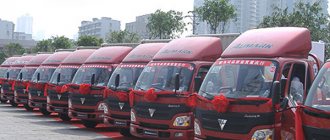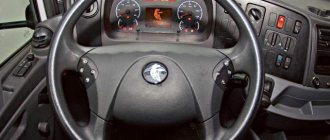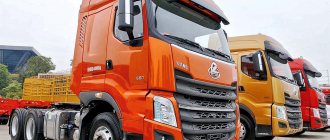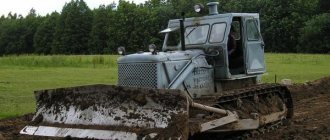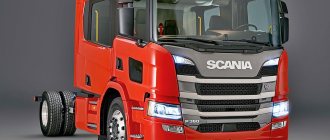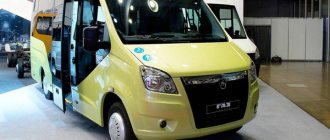Home Brands Volvo Volvo FH13
European trucks are distinguished by their stylish design, high level of comfort and reliability. The Swedish Volvo FH13 was no exception to the rule. The vehicle is used for long-haul transportation, as part of road trains, as a tractor or chassis. The vehicle has quite impressive load-carrying capacity (capable of transporting loads weighing up to 44 tons). It is a safe, reliable, comfortable and powerful truck that compares favorably with cars in its class. The car is assembled in Sweden, Belgium, and Russia (Kaluga).
Model history
The history of trucks began back in 1993. It was then that three models were presented to the general public - , 13, and. The development of cars took several years, based on a completely unique and unparalleled project.
Swedish Volvo heavy-duty trucks had a number of innovative solutions in their design for their time. In particular, it is worth highlighting the durable steel cabin of the Volvo FSh13, which is spacious and safe. At the same time, aerodynamics were not affected either, thanks to the streamlined shapes and rounded edges.
Attention! The first generation vehicle differed favorably from vehicles of a similar class not only in its technical characteristics and design features, but also in its bright and stylish appearance, unlike the design of other trucks.
Five years after the official release, in 1998, the car underwent restaling. The car received minor design improvements to the cabin, and all attention was focused on the power units - the model began to be equipped with more powerful and efficient engines.
In 2001, the second generation Volvo FH13 was released. It received a completely redesigned cabin - the shape of the radiator grille became more aggressive, and the head optics were combined into a single unit. Working conditions for drivers have also improved significantly. Modifications of the truck began to be equipped with completely different power units, characterized by good efficiency and compliance with environmental safety standards in force at that time. The design features of the second generation include the use of advanced design gearboxes - I-shift - as transmissions.
Seven years later, in 2008, the second generation of the truck underwent restaling, becoming safer and more comfortable. The driver of the Volvo FSh13 now has access to a large number of different electronic systems, which greatly facilitate the operation of heavy trucks and increase overall safety.
The third generation car was officially introduced in 2012. The appearance of the model has become more modern, original and futuristic. The car received an independent front suspension, and the space inside the cabin was increased. The interior design materials have undergone a number of modifications, and the range of installed electronic systems has also been increased. The power plants of the third generation model began to comply with the EURO-5 environmental safety standard.
Attention! The letters and numbers encoded in the Volvo FH13 name have the following designations: “F” indicates that the truck has a cabover layout, and “H” indicates that the cab is installed above the frame.
In Russia, truck tractors with a 4×2 wheel arrangement are most often used.
A construct that decides a lot!
The thrill of driving a truck is good, but now that I'm on the side of the road, I want to take a look at the details that will help you understand why the Volvo Ocean Race is such an amazing experience.
I immediately notice two capacious fuel tanks. On the left - 900 liters, on the right - 530 liters of diesel fuel and a 90 liter “tank” for AdBlue reagent. The wheelbase of the tractor is quite short - 3800 mm, so I found the batteries, covered with plastic shields, in the rear overhang, and the air receivers are also located there. The designers decided to immediately put this slightly unusual layout to good use: at the end of the frame I found a separate panel with air fittings and a 24 V power terminal for “lighting up”, and all this equipment can be used without problems even with a semi-trailer: access is normal.
The air preparation unit and filter separator are located inside the frame, which helps protect them, but makes maintenance difficult. Now let's raise the cabin. Don’t forget to open the hood first, and how can you forget if the corresponding tool is located right here, carefully placed in special grips. You will have to lift it manually, no electric drives! This seems like a sneaky move by some branded automakers, which I've already noted several times. In fact, the more serious the tractor, the more difficult it is to get to its insides: perhaps this is a kind of hint at reliability and durability, they say, there is no need to climb in there, everything works fine and will continue to work. I have to disagree with you, dear gentlemen! We are in Russia, and anything can happen on our road, and we are used to doing a lot of things on the car ourselves, even with a sledgehammer and on the dusty side of the road, but sometimes this is the only way to continue driving and go further... Here, even to the air filter access only after lifting the cabin; this cannot be avoided if you need to work on the filter separator, which often happens in cold weather. But thanks for the separate ramp with “trailer” connections, which does not rise with the cabin - you don’t have to worry about tearing off the hoses and cables.
Another important, but controversial point for me. Algorithmization of the Volvo FH electronics allows the cabin to be raised while the engine is running, this is convenient for a person with confident plumbing skills - you can literally find a malfunction or detect the source of extraneous noise “on the fly”, but you can also be injured if handled ineptly. However, if you don’t know how and don’t know, then there’s no need to go there. Surprisingly, the design of the cabin suspension here is very simple - shock absorber struts at four points and no air suspension. And yet, excellent smoothness is ensured in the workplace. And this despite the fact that a truck tractor unencumbered by a semi-trailer is, by definition, a “goat”! The highest score is for the absence of unnecessary complications in the form of pneumatics without sacrificing comfort!
Design
The appearance of the third generation model looks stylish and modern. Elegant headlights have an irregular trapezoidal shape. A little lower, in a separate block, there are daytime running and side lights. The design of the front part is complemented by a massive cellular radiator grille, with two trapezoidal air intake inserts; above the grille there is a panel with the characteristic Volvo logo.
The car has a large windshield, over which the outer sun visor protrudes slightly. The sides of the cabin have elegant stampings.
Attention! Optionally, an aerodynamic wing or additional lighting devices, for example, flashing lights, additional side lights or fog lights, can be installed on the roof of the Volvo FSh13.
Salon Volvo FH13
The third generation tractor has a comfortable and stylish interior. The interior is decorated with gray plastic that is pleasant to the touch. The build quality is also excellent - even in used cars, there are no squeaks, knocks or crunches. A tinted sunroof is installed on the roof: it visually makes the cabin even more spacious and high, and in the event of an accident, it can be used as an emergency exit. It is standardly equipped with a curtain, a mosquito net and, optionally, electronic controls.
The driver's seat is trimmed with high-quality, pleasant-to-touch fabric in gray and beige tones. The seat design has armrests. The updated seat profile allows even tall people to operate the truck comfortably, and well-implemented lateral support makes driving a pleasure.
The truck's steering wheel is adjustable for tilt and reach, and the pedals are at a comfortable height for both short and large drivers. The car has an option that allows you to move the steering wheel when leaving the cab. The dashboard contains large instruments, backlit, allowing you to read information both during the day and at night. The center console has a curved shape, which is why the main controls are turned towards the driver. An advantage is the presence of compartments, recesses, and door pockets for storing personal items.
As standard, the Volvo FH13 truck is equipped with an advanced climate control system, a multimedia system and a navigator. As for the sleeping place, it is quite comfortable; the headboard can be adjusted in height. An individual lamp and a small table are provided. Under the sleeping bag there are refrigerators for storing drinks and food.
For the ocean of long haul flights
Along with aviation analogies, the cabin can be compared to the cozy captain's cabin of an ocean cruise liner. The “sleeping bag”, for the sake of the range of adjustments of the driver’s seat, is uneven in width, but the pilot, captain or driver can now move back by 24 cm. The dimensions of the “bed” are 815x2000 mm. The upper sleeping bunk folds at an angle of 52° and has a size of 700x1900 mm. Drivers will also be pleased to find in the cabin many drawers and pockets for small items with a total volume of about 200 liters and a 33-liter refrigerator with a freezer. An ocean of blue sky can be seen through the high ceiling with a transparent sunroof. There is no trace left of the previous cramped conditions that drivers of the previous generation Volvo FH complained about! This cabin has a new power frame, different proportions, height and internal volume, increased by 1 m3. In a word, live, work, enjoy.
Technical characteristics of the Volvo FH13 Ocean Race car
| Total weight, kg | 19 000 |
| Gross weight of the road train, kg | 44 000 |
| Permissible load on 1st/2nd axles, kg | 7500/13 000 |
| Engine: type displacement, l power, hp. torque, N∙m | Volvo D13C Diesel, 6 cylinders in line 12.9 500 at 1900 min-1 2500 at 1050–1400 min-1 |
| Transmission | Automated, Volvo I-Shift |
| Rechargeable batteries, A∙h | 2x225 |
| Suspension | Front – leaf springs, rear – pneumatic |
| Brake system | Pneumatic |
| Wheel formula | 4x2 |
| Tire size | 315/70 R22.5 |
| Fuel tank capacity, l | 900+530 |
Engine and gearbox
| Characteristics | Indicators |
| Engine | Volvo D13A |
| Power | 520 horses |
| Fuel | diesel fuel |
| Cylinders | 6 |
| Torque | 2300 Nm |
| Unit volume | 12.78 l |
| Environmental class | Euro 5 |
| Tank capacity | 1480 l |
The car is equipped with a 6-cylinder in-line diesel power plant. Each cylinder, in turn, is equipped with four more valves. The engine has power from 400 to 520 horsepower. The engine displacement is 13 liters.
The engine works in conjunction with a 12-speed robotic gearbox. A number of modifications are equipped with a 14-speed manual transmission.
Along an alternative route
Residential buildings surrounded by the Volvo Vostok office and the middle of the working day declared war on freight transport. Getting out of the wilds of the urban jungle was constantly hindered by dense “vines” of signs prohibiting freight and transit traffic. However, I did not lose heart and soon unexpectedly discovered a suitable solution that allowed me to literally kill two birds with one stone! I decided to try out the recently inaugurated section of the M11 Moscow-St. Petersburg expressway. It’s decided: to the highway on a highway tractor!
I climb into the cabin using a very high ladder. Oh, isn't this a construction dump truck? No, it’s just that for the versions of the sixth environmental class that we tested in Sweden, more space above the engine is needed for cooling system components, and it is impractical to “sharpen” the cabin for each sales market... But inside the mobile home there is an almost flat floor and an absolutely flat ceiling, a decent height another apartment, but more on that a little later, now I can’t wait to get behind the wheel.
Volvo FSh13 chassis
The car is quite easy to drive. This is largely ensured thanks to the exchange rate stability system and dynamic steering.
The truck's suspension has three or two leaf front springs and a rear 4-bar pneumatic system. The vehicle is equipped with disc brakes, but some modifications of the truck may have drum brake systems. The parking brake is activated using a button. Electronics allows you to activate the handbrake in automatic mode.
Prices
The new option will cost the driver between 3.7 and 4 million rubles, depending on the type of modification and the configuration of the truck. Used cars will cost drivers in the range from 1.5 to 3 million rubles; the final cost of the truck in this case is influenced by optional equipment, the number of kilometers driven, as well as the general technical condition. In some cases, renting a car will be economically feasible: you can rent a truck for 7,500 rubles per shift.
This is a comfortable and reliable Swedish heavy-duty vehicle. The model, developed in 1993, has been constantly improved both technically and in terms of providing comfort for drivers. The third generation truck has a futuristic and modern design, has increased comfort, boasts excellent technical equipment, and high reliability.
These qualities make the car truly useful for long-distance cargo transportation. One of the disadvantages of the Volvo FH 13 is its high cost, but it is compensated by the reliability of the truck, which subsequently saves on frequent repair work.
Feel like a pilot
The plane began to descend, and a few minutes later landed at one of the airports. This is exactly how one can describe the end of a journey on a road train, where the tractor unit is the new Volvo FH. The car’s emphasis on safety is expressed in a huge cluster of on-board systems that protect the driver, passengers, vehicle and other road users, including the environment. Even the basic equipment of the tractor is rich in various electronic driver assistance systems, and the capabilities of this equipment have gone so far that it is time to recall the work of the pilot of a modern civil airliner, who manually only performs takeoff and landing, and then under close electronic control. On an ordinary earthly, albeit modern premium tractor, the corresponding system (EBS) will help you move uphill, adaptive cruise control (ACC) will help you maintain a safe distance, numerous cameras will monitor the intersection of road markings, changes in illumination and the onset of precipitation, and “smart” headlights they will look around the corner when cornering (LCS, LKS, DAS, Cornering lights), directional stability will, of course, be monitored by ESP, “just in case” – the fire extinguishing system of the engine compartment.
To keep fuel consumption and harmful emissions to a minimum, like an intelligent air traffic controller, the I-See system will remember the longitudinal profile of the route using GPS, and when driving along this section, it will again optimize engine speed and the selected gear. The wireless telematics system will ensure long-term trouble-free operation using new wireless technology introduced on the new range of Volvo Trucks, ensuring constant wear monitoring of key components. From their computer, service center specialists can remotely diagnose the condition of various components and assemblies, and if wear progresses dangerously, a signal will come from the center (and it begs to be added to “mission control”)! This way, you can quickly set a maintenance date at a time convenient for the client, and sometimes even complete the trip without the help of a tow truck.
